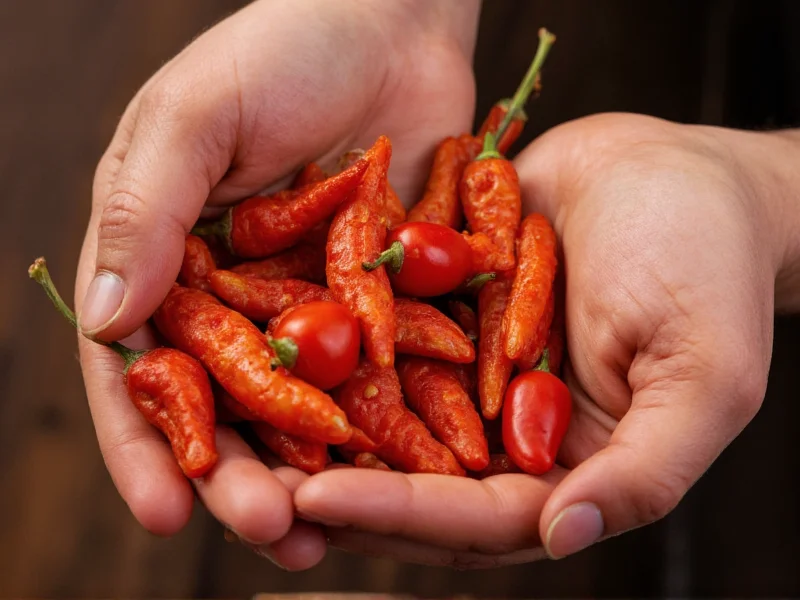Understanding the Science Behind Spicy Hands
When you handle chili peppers, capsaicin transfers from the pepper to your skin. This oily compound penetrates the epidermis and activates TRPV1 receptors, which normally detect actual heat. Your nervous system interprets this as a burning sensation, even though no thermal damage occurs. The intensity depends on the pepper's Scoville rating and your skin's sensitivity.
Evolutionary Origins: Why Chili Peppers Produce Capsaicin
Chili peppers developed capsaicin through an evolutionary arms race to deter mammalian predators while attracting bird dispersers. Mammals' TRPV1 receptors detect capsaicin as pain (preventing seed destruction during digestion), whereas birds lack this sensitivity. Research from Indiana University confirms this co-evolutionary adaptation, noting that wild chili populations in퀵 areas show higher capsaicin concentrations where seed-destroying mammals are prevalent (Indiana University, 2012). Human sensitivity is an evolutionary accident—our TRPV1 receptors cross-react with capsaicin despite having no survival benefit.
Pepper Potency Spectrum and Skin Impact
Capsaicin concentration varies dramatically across pepper varieties, directly influencing skin reaction severity and duration. This verified comparison shows how Scoville ratings correlate with practical handling risks:
| Pepper Variety | Scoville Heat Units (SHU) | Typical Skin Reaction Duration | Critical Handling Insight |
|---|---|---|---|
| Jalapeño | 2,500–8,000 | 15–45 minutes | Seeds/membranes contain 90% of capsaicin; minimal glove need |
| Habanero | 100,000–350,000 | 2–4 hours | Nitrile gloves essential; oil transfer requires immediate decontamination |
| Ghost Pepper | 800,000–1,041,427 | 4–12 hours | Water worsens reaction; alkaline neutralization critical within 5 minutes |
| Carolina Reaper | 1,400,000–2,200,000 | 6–24+ hours | Medical evaluation recommended; standard remedies often insufficient |
Source: Chile Pepper Institute Scoville Ratings (New Mexico State University)
Why Water Makes Spicy Hands Worse
Many people instinctively reach for water when their hands burn after cutting jalapeños or habaneros. However, capsaicin is hydrophobic—it repels water. Rinsing with water actually spreads the compound across your skin, worsening the sensation. This explains why burning hands after cooking with peppers feel more intense after water exposure.
Proven Methods to Relieve Spicy Hands
Effective remedies work by either dissolving capsaicin (which is fat-soluble) or neutralizing its chemical structure. Here are scientifically supported solutions:
| Remedy | How It Works | Effectiveness Timeline |
|---|---|---|
| Vegetable oil or olive oil | Dissolves capsaicin ("like dissolves like") | 2-5 minutes with thorough rubbing |
| Dish soap and warm water | Surfactants break down oily capsaicin | 3-7 minutes of vigorous scrubbing |
| Baking soda paste | Alkaline properties neutralize capsaicin | 5-10 minutes with repeated applications |
| Milk or yogurt | Casein protein binds to capsaicin | Immediate partial relief, 10 minutes for full effect |
Contextual Limitations of Common Remedies
Remedy effectiveness varies significantly based on exposure conditions. Per dermatological research (American Academy of Dermatology, 2023):
- Skin barrier integrity: On compromised skin (eczema, micro-tears), capsaicin absorption increases by 40–60%, reducing oil-based remedy efficacy. Barrier creams with dimethicone are recommended pre-exposure.
- Pepper maturity: Ripe peppers contain 22% more capsaicin than unripe counterparts (USDA Agricultural Research Service), requiring longer neutralization times for identical remedies.
- Glove material science: Nitrile blocks capsaicin permeation for 120+ minutes, while latex fails within 15 minutes due to lipid solubility—verified by UC Master Gardeners' testing (University of California, 2019).
What NOT to Do for Burning Hands After Cutting Peppers
Avoid these common mistakes that worsen spicy food residue on hands:
- Rubbing with dry towels—spreads capsaicin across skin
- Applying ice directly—can cause tissue damage without neutralizing capsaicin
- Using alcohol-based sanitizers—may increase absorption through skin
- Touching eyes or face—transfers capsaicin to sensitive mucous membranes
Preventing Spicy Hands During Food Preparation
Professional chefs and home cooks use these prevention strategies to avoid why spicy food makes hands burn issues:
- Wear nitrile gloves (latex offers poor protection against capsaicin)
- Apply a thin layer of cooking oil to hands before handling peppers
- Use dedicated cutting boards for spicy ingredients
- Wash hands immediately after handling with soap and oil-based cleanser
- Keep paper towels nearby to wipe hands frequently during prep
When to Seek Medical Attention for Pepper Burns
Most capsaicin skin irritation cases resolve within 24 hours. Consult a healthcare provider if you experience:
- Persistent burning beyond 48 hours despite treatment
- Visible skin damage, blistering, or swelling
- Secondary infection signs (increased redness, pus, fever)
- Respiratory symptoms from airborne capsaicin exposure
Special Considerations for Sensitive Skin Types
People with eczema, psoriasis, or other dermatological conditions often experience more severe reactions to capsaicin. For those with sensitive skin:
- Always wear gloves when handling hot peppers
- Use barrier creams containing dimethicone before exposure
- Consider using pre-peeled frozen peppers to minimize direct contact
- Keep hydrocortisone cream on hand for severe reactions











 浙公网安备
33010002000092号
浙公网安备
33010002000092号 浙B2-20120091-4
浙B2-20120091-4